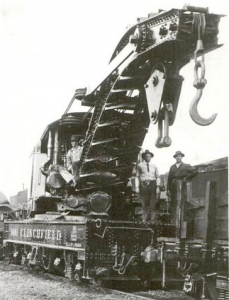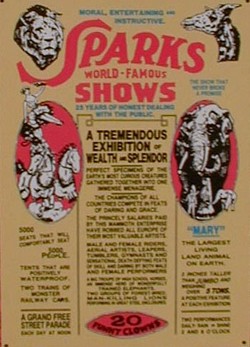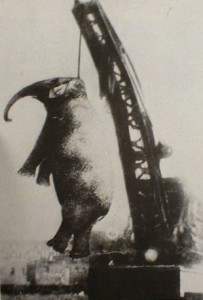Caution: This tale is morbid and not for the faint at heart. Read at your own discretion.
The use of animals in public performances, whether it be at Sea World or a Circus, is a taboo subject. I have no qualms with saying I’m against it, outright. The stories of abused and neglected animals in these situations are a plenty, but the following tale of Mary the elephant is far more morbid than anything I’ve ever read. I’ve cautioned you once about the content of this article, and I’ll do it one more time: this is not a story with a happy ending; it is one of disgusting injustice.
During the early Twentieth Century, Sparks World Famous Show, a chintzy circus, employed many animals. One of those animals was a 5-ton, 4 year old elephant named Mary. She was first elephant purchased by owner Stephen Sparks in 1896 and spent twenty years with the show before her tragic demise. Publicized as “The Largest Living Land Animal on Earth,” she was the chief draw for the circus, which was desperate to compete with John Robinson’s Four Ring Circus menagerie.
Late in the summer of 1916, Mary’s trainer Louis Reed left the show and was replaced by Paul Jacoby. However, due to staff turnover, the elephants also required an ‘under keeper’ to look after them when not in training. As such, Walter “Red” Eldridge, a hotel worker, was hired as their steward. This was not a wise decision for he had no previous experience with wild animals, let alone elephants.
On September 12th, the circus arrived in Kingsport, Tennessee. During a break between shows, Red took the elephants to a watering hole. On the way back to the tent, Mary discovered some watermelon rinds on the side of the road and went to nibble on them. Red proceeded to unceasingly jab her ear with a bull hook until she became enraged. The story from here on varies (accounts conflict) – according to this version, she
“collided her trunk vice-like [sic] about [the under keeper’s] body, lifted him 10 feet in the air, then dashed him with fury to the ground … and with the full force of her biestly [sic] fury is said to have sunk her giant tusks entirely through his body. The animal then trampled the dying form of Eldridge as if seeking a murderous triumph, then with a sudden … swing of her massive foot hurled his body into the crowd.”
Undoubtedly, this version of the story was sensationalized. However, what followed next elevated Mary to legendary status.
Owner Stephen Sparks, prodded by media attention and town threats to ban the circus, knew he had to euthanize Mary the “Mankiller.” But how? Bullets wouldn’t do the job, and she apparently survived shots from a rancorous crowd in the aftermath of the trampling. Further, the town didn’t have the electrical power available that Thomas Edison had once used to slay an elephant “during his weird campaign for the electric chair” (something I didn’t know or want to know about Edison).
Mary’s doleful fate is something I’m not equipped to narrate. The sheer morbidity of her execution evades my eloquence. It is better (?) curtailed in an article from ExecutedToday.com:
 The choice for the baleful logistical task of killing a 10,000-pound evildoer was hanging, selected over “crushing it between railroad cars.”
The choice for the baleful logistical task of killing a 10,000-pound evildoer was hanging, selected over “crushing it between railroad cars.”
And for stringing up “Murderous Mary”, you need no ordinary gallows. No, for this job, you’re using the hoist on a train derrick and an industrial-strength chain for a noose.
The railroad was game for the operation, provided the circus would come to it. So on this date, the circus train cars loaded up for the nearest usable scaffold at Erwin, Tennessee.
There, a procession of all five Sparks elephants — the routine was supposed to keep Mary compliant, and it did the trick even though some observers later remembered the condemned creature behaving unusually skittishly — marched to the rail yard.
There Mary was noosed with a 7/8 chain and hoisted up. The chain broke, and the animal shattered its hip crashing to the ground; another, still larger, chain, did the trick on the second try.
Pitiful, shameful and grotesque is the tale of Mary the elephant’s execution. While this is certainly a morose subject, it uniquely highlights the danger of employing wild animals in entertainment and serves as a cautionary tale of animal abuse.

